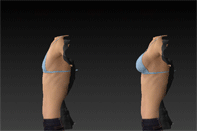In 2016, the number of facelifts performed in the U.K. fell to a staggering 40% of what they were just one year prior. Many newspapers picked upon the downward trend and people started to wonder if facelifts were a thing of the past. Considering how social media has grown in popularity, it would stand to reason that the number of facelifts performed should be on the upswing.
According to plastic surgeon Dr. Jason Pozner, the above decline is only for the U.K. Here in the U.S., the number of facelifts performed over the past 10 years has fluctuated by only 5% or so. He goes on to say that he’s performing more facelifts now than ever due to the non-surgical treatments such as Botox and fillers – which act as a sort of “gateway drug” to more invasive surgical procedures.
Societal trends and non-invasive surgery treatments are both contributing to the delay and/or decline in undergoing the knife. We’re going to look at several reasons that could explain this trend in an attempt to understand what’s going on with facelifts.
Social Media Stars
Anyone with a webcam, social media account, and pretty face can be a social media star. Just 15 short years ago, model and talent agencies would hire people who had to conform to a certain physical look that they had in mind. Nowadays, anyone with a popular Instagram or Twitter page can go onto fame and fortune.
The rise in social media celebrities who focus on beauty and beauty products is a contributing factor in the delay of many people getting a facelift. They tend to be more relatable than the big celebrities you see on T.V. This factor alone is why they are so popular with the average person. “If they can do it, so can I” is the mindset that many people have.
Due to their lack of wealth, they are always on the lookout for the latest and greatest non-surgical beauty treatments that won’t require thousands of dollars and longer healing times.
This trend has only served to increase the popularity of such minimally invasive techniques as Botox, Kybella, and dermal fillers. After all, it’s a lot easier (and less expensive) to walk into a dermatologist’s office and walk out 30 minutes later after getting Botox and filler injections.
Non-Invasive – Not for Everyone
Part of the reason why facelifts haven’t decreased dramatically in the U.S. is because non-invasive treatments aren’t for everyone and they can only help so much. Non-invasive treatments usually don’t last more than 6 months or so until their beneficial effects wear off. Getting Botox treatments bi-annually for just a few years can actually cost more than certain surgical procedures.
Botox and other non-invasive procedures are a fantastic way for people to get accustomed to how well plastic surgery works. Once they realize that Botox and fillers can only do so much, they start to get curious about how much better they would look if they had a facelift. While it hasn’t been studied in-depth, it’s reasonable to assume that non-invasive techniques can delay a person decided to go under the knife for at least a year or two.
There are also other people whom Botox and other injectables won’t help. Their aesthetic issues can only be solved by undergoing the knife. They usually come into the surgeon’s office for a consultation about Botox and wind up opting for surgery after they learn of the limitations of injectables.
Delay in Patients Getting Facelifts
When plastic surgeons see patients in their initial consultation, it’s mostly to let them know what they can fix and how it can be fixed. Every patient they see for facial rejuvenation usually starts off very conservatively with some type of Botox or filler treatment. As time goes by, the patient starts to realize that if they want permanent results, they’ll have to go under the knife.
One of the biggest delay factors in patients agreeing to get plastic surgery is the fear of the knife. Unless they need immediate surgery due to a medical issue or accident, most people tend to flirt with non-invasive techniques for a few months to a few years before finally deciding to get the surgical procedure done so they won’t have to deal with getting injected with needles every 6 months.
Conclusion
The demand for facelifts is slowing down, but not declining. Eventually those people who get Botox and other injectables done on a regular basis will grow tired of it, the continual expense, and limitations as to what it can do, and finally opt to undergo a facelift. While injectables work very well for many people, they only work so well and last for so long.
If Botox and injectables aren’t giving you the results that you desire, or you’re looking for something more permanent, schedule a consultation today. Dr. Adams and his staff will help answer any questions you might have, and their offices are conveniently located in the Dallas area.















